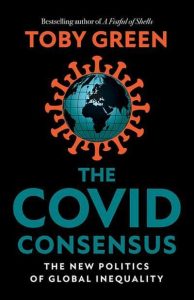In The Covid Consensus: The New Politics of Global Inequality, Toby Green critically examines the emergence of the scientific consensus surrounding COVID-19 lockdowns, arguing that it has amplified global inequalities. Providing an interesting retrospective analysis of the steps taken during the COVID-19 pandemic, this is a valuable addition to research exploring lockdown and inequality debates, writes Chinmayee Mishra.
The Covid Consensus: The New Politics of Global Inequality. Toby Green. Hurst Publishers. 2021.
 Find this book (affiliate link):
Find this book (affiliate link):![]()
Intractable disagreements are common on various world issues as it is very hard to reach a global consensus. However, in The Covid Consensus: The New Politics of Global Inequality, Toby Green writes that within only a few weeks of the spread of the COVID-19 virus, most countries agreed on the ‘scientific consensus’ of lockdown policy. The author explores the reasons for this consensus and the ways it has amplified global inequalities.
The dichotomies of science and social science, Global North and Global South, rich and poor and Left and Right ideologies can be seen as broader frameworks running through the book. Green views lockdown as the most intrusive public health measure in world history. It resulted from the politicisation of the public health crisis. He argues that the increasing mediatisation of reality and the polarisation of public opinions through social media platforms created the hype around the crisis.
Green enumerates the winners and losers of the lockdown process. While technological giants, pharmaceutical companies and remote workers benefited from lockdown, people engaged in art and culture, the hospitality sector, women, children and many others, especially in the Global South, were adversely impacted. These beneficiaries directly and indirectly helped in shaping the consensus for the lockdown. Green asserts that different socio-economic realities were ignored by following a blanket approach for all.
The second chapter of the book begins by drawing wartime comparisons to show the inversion of moral judgment during the COVID-19 crisis. Unlike during World War Two, citizens were instructed to sacrifice the future for the present. Green raises the question of the proportionality of benefit to loss during the first lockdown. The pandemic has resulted in the loss of lives. However, the lockdown also caused a loss of material wealth and affected the mental health of individuals. COVID-19 obsession in the health sector derailed the treatment of other serious ailments like cancer and heart disease. The balance of one set of risks over others was not weighted and policies were rolled out hastily. Green exposes the reasons why authorities did not acknowledge the initial failure to evaluate these risks.

Image Credit: Photo by Cole Freeman on Unsplash
By bursting the myth that COVID-19 is a great leveller, Green describes the devastating socio-economic and health impact of the international response to the pandemic in the Global South. He questions the abandonment of the global poor by policymakers. Ethical consideration for vulnerable populations was also obscured by the chaos created during the outbreak of the COVID-19 pandemic. The tradition of unfulfilled pledges continues, which could have otherwise helped in combating some of the losses of lockdown. Eventually, the countries of the Global South had to use their reserves for immediate relief, which Green argues could have been invested later on in health and education. The policies of the Global South are influenced by the Global North. The adoption of similar lockdown policies as those of the Global North, ignoring domestic realities, backfired by increasing the inequality gap between the Global North and South.
The sprawling range of issues resulting due to lockdown, from livelihoods to migration, is discussed in the book. The author broaches questions regarding the quick shaping of the consensus. He is amazed to find people willingly ceding their rights to fight a disease, including in liberal democratic societies where freedom is fundamental. He argues that the estrangement of people from democratic capitalism has paved the way for ‘authoritarian capitalism’ to be implemented. In authoritarian capitalism, a capitalist market economy exists alongside an authoritarian government. Green predicts that authoritarian capitalism may take over from democratic capitalism in the post-pandemic phase.
Finally, Green seeks to understand the truth behind the emergence of the COVID consensus and its corresponding consequences. This is a must-read book for those who are engaged in both anti-lockdown and pro-lockdown discourse. Green’s book will trigger some serious questions and arguments to ponder. It deals with intricate details regarding the development of the consensus which Green boldly states with conviction.
Some of his arguments are stronger than others as these have been substantiated not by perception but with evidence. However, the argument relating to the acceptance of authoritarian capitalism by liberal democracies assumes a contextual and contestable interpretation. The reaction time was less during the first lockdown and people had limited knowledge of the novel coronavirus. As a result, they accepted the authorities’ orders without questioning them because it was in the context of a public health crisis. Still, there has been resistance to COVID-induced lockdowns in countries of both the Global North and Global South, where people have participated in anti-lockdown protests. Secondly, the book has devoted less space to the benefits of lockdown in places in the Global South where the number of public health facilities is disproportionately small relative to the size of the population.
Nonetheless, there is much to admire in this book as it provides us with an interesting retrospective analysis of the steps taken during the COVID-19 pandemic. Acknowledging the lapses pointed out by Green will help in preparation for facing future pandemics. Green’s book is timely and a valuable addition to COVID-19 research dealing with lockdown and inequality debates.
Note: This review gives the views of the author, and not the position of the LSE Review of Books blog, or of the London School of Economics and Political Science. The LSE RB blog may receive a small commission if you choose to make a purchase through the above Amazon affiliate link. This is entirely independent of the coverage of the book on LSE Review of Books.







